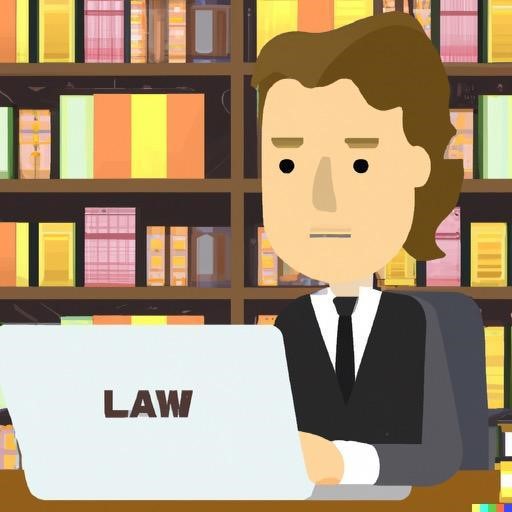AI-generated imagery is taking the world by storm. Consumer-facing AI systems such DALL-E 2, Stable Diffusion, and Midjourney are able to near-instantly generate impressive visual works based on textual prompts. The systems employ “generative modeling”—a branch of machine learning tasked with creating complex outputs from input data (as opposed to more common flavors of machine learning, such as classification or prediction algorithms).
As a meta-reference, here’s a DALL-E image I generated of my writing this blog post.

The burgeoning availability of AI imagery systems and the proliferation of their resulting creations will have radical impacts on the digital arts landscape. The rise of AI imagery also implicates various intellectual property issues, which this blog post aims to illuminate.
Copyright considerations span the lifecycle of AI-generated imagery: from the input prompts, to the AI modeling process, to the resulting image.
Copyrightability of input prompts seems relatively straightforward. OpenAI, the creator of DALL-E 2, writes in its terms of use that, “[t]o the extent allowed by law and as between you and OpenAI, you own your Prompts…” Here, OpenAI seems to be acknowledging that a sufficiently expressive prompt could be entitled to copyright protection. The limiter here is copyright law’s idea-expression dichotomy; in contrast to the relatively expressive prompt used to create the image above, a prompt such as “a law student” would suggest a mere idea. Since precise and creative prompts are becoming crucial to generate compelling imagery, “prompt engineering” is becoming a skill in its own right. PromptBase, the first mover in the AI-prompt marketplace industry, is capitalizing on this newfound opportunity to bring prompt buyers and sellers together.
Copyright issues around the AI modeling process are a bit murkier. The machine learning models powering these generative systems are trained on a massive number of images scraped from the web. This training data is composed of copyrighted and uncopyrighted material. The Ninth Circuit, in hiQ Labs, Inc. v. LinkedIn Corp., 2022 WL 1132814 (9th Cir. Apr. 18, 2022), ruled that public web scraping as a practice is legal—at least with respect to the Computer Fraud and Abuse Act. However, the interaction of copyright protection and web scraping for AI use is less clear (i.e. whether a system scraping, but not reproducing, copyrighted images to feed into an algorithm incurs liability, and if this process fits into copyright’s fair use doctrine). The modeling process also raises a more existential question about generative art: is an AI system leveraging training data like an artist looking to other artists’ works for inspiration—a natural part of the traditional creative process—or is it more akin to copying?
The resulting imagery implicates two distinct copyright issues: non-human “creation” and the copyrightability of AI-generated work.
The U.S. intellectual property regime has thus far been hesitant to recognize any form of non-human creation or invention. The paradigmatic example of a non-human copyright dispute is Naruto v. Slater, 888 F.3d 418 (9th Cir. 2018), in which the court decided that a monkey named Naturo lacked statutory standing under the Copyright Act to file an infringement suit for the “selfies” it had shot using a wildlife photographer’s camera. In February 2022, Researcher Stephen Thaler similarly failed in his attempt to register an algorithm used to create an image as the non-human copyright holder of its creations. The Copyright Office, in rejecting the request upon appeal, found that the image “lack[ed] the human authorship necessary to support a copyright claim.” The Federal Circuit adopted a comparable stance for AI invention in the patent context in Thaler v. Vidal, Appeal No. 2021-2347 (Fed. Cir. Aug. 5, 2022). Writing for the court, Circuit Judge Stark proclaimed, “there is no ambiguity: the Patent Act requires that inventors must be natural persons; that is, human beings.”
The Copyright Office has not explicitly ruled on the copyrightability of AI-generated imagery; it has simply refused, as in Thaler’s copyright case, to recognize an AI system as the author of a work. In September 2022, New York-based artist Kris Kashtanova claimed, via an Instagram post, to have received a registered copyright on her AI-generated graphic novel, Zarya of the Dawn (whose titular character bears an unmistakable resemblance to the actress Zendaya). However, Gizmodo reviewed the publicly available copyright registration documentation and found that it does not explicitly reference AI, despite Kashtanova claiming she listed Midjourney on the work’s cover page and was forthcoming about her use of unedited AI-imagery for the novel’s artwork. Since, as Gizmodo reports, it is likely that the AI issue was not squarely before the Copyright Office, the issue of copyrightability of AI-generated work remains unaddressed.
The proverbial genie is out of the bottle with respect to AI imagery, and U.S. intellectual property law has not adequately addressed its profound implications. Due to the current legal uncertainty, the stock image platform Getty Images announced in September 2022 that AI-based imagery will not be allowed on its site; more platforms will likely follow suit. As this technology evolves from experimental uses to commercial and non-commercial use that pervades aspects of our lives, the need for legal clarity will be essential. The Copyright Office and courts will have to address the hard questions around non-human creation in an AI context, copyright’s intersection with web scraping and machine learning model training data, and the copyrightability of AI-generated imagery. In doing so, they will have to decide whether these systems are more analogous to a monkey taking a photograph or the camera itself, guided by expressive human choices in selecting the tool, creating the prompt, and ultimately deciding to create a visual work using this new method.
